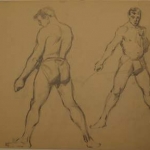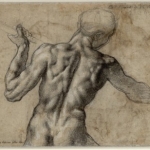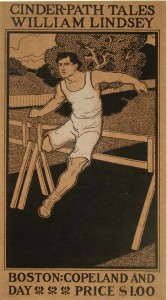
Frank B. Nuderscher (1880-1959)|Man and press|Cover illustration for The Inland Printer (September 1903)
Throughout his life Frank B. Nuderscher primarily lived and worked in St. Louis and was best known regionally as a painter of landscapes and city views of his area. It is unexpected then, to find that in 1903 he also created the above cover illustration for the popular Chicago trade magazine, The Inland Printer.
In the 19th century American explosion of printed materials, trade magazines were formed focused on information for a specific industry, trade, or profession. The Inland Printer was created in October 1883 as a local trade magazine for the booming mid-western printing industry. That first issue was “twenty-four pages, thirteen of copy and eleven of advertisements.”* Eventually this little monthly periodical became the bible of the printing industry and is still viewed as a primary source of historical information on that trade with some issues running for as many as 200 pages. In 1894, The Inland Printer became the first American magazine to have a new cover designed for every issue. Some of the most influential of illustrators of the day created distinctive covers for the magazine, including Will Bradley and the brothers J. C. and Frank X. Leyendecker.
Nuderscher’s cover design for the September 1903 issue of The Inland Printer shows a young man pulling a hand press. This image is based in a bit of nostalgia, since by then technological advances in the printing industry were rampant, and it is also classically derived. In 1903, Nuderscher was probably just finishing his artistic studies that began in St. Louis and then took him to England, Germany, and France. The standard artistic training for all artists included making copies of older works of art from reproductions; copies from plaster casts; and finally, studying the figure from nude models.

Frank B. Nuderscher|Figure Study; Two Views of Male Figure, c. 1913|Pencil on paper|Collection of the St. Louis Mercantile Library at the University of Missouri- St. Louis**
This process would have included studying the old masters, such as those by Michelangelo, seen below. While he may not have known this specific drawing, he certainly would have been familiar with Michelangelo’s style of rendering a muscular body.

Michelangelo Buonarroti|Male Nude Seen From the Back with a Flag Staff, c. 1504|Collection of the Albertina, Vienna
Nuderscher’s image is also reminiscent of the young John Sloan’s 1896 book cover and poster image for William Lindsey’s Cinderpath Tales, see below. Except that Sloan used the brown paper of the poster and book jacket as the unifying background and primary color for his illustration. Instead of using the color of the paper as the background, Nuderscher laid his brown paper background color via print ink and then overlaid that with black and white inks to define the scene. The gray paper stock merely serves as the background for the periodical’s factual information.

John Sloan|Cinder-Path Tales, 1896|Promotional Poster|Delaware Art Museum, gift of Helen Farr Sloan, 1977-268
Because Nuderscher’s figure is nude we certainly pay more attention to the man’s body than we do to Sloan’s running and leaping figure which is more about movement than about form. But the real question is who would actually work a printing press wearing only a craftsman’s leather apron? Because of this incongruity it took me longer to realize that the man’s trimmed and neatly styled and precisely parted hair was also odd compared to the explosively expressive body form. The pages of paper floating down from the press belie the heft of the hand press and the wet stickiness of the ink laden paper. Despite these inconsistencies, this unusual and powerful design allowed this young artist to show his considerable ability rendering the well-defined muscles of a nude male body pointedly focused on the printing trade.
*Maurice Annenberg, A Typographic Journey Through the Inland Printer 1883-1900 (Baltimore, MD: Maran Press, 1977): x.
** My thanks to Dr. Julie Dunn-Morton, Curator of the Fine Arts Collections at the Mercantile Library, UMSL, for providing this image and her assistance with my research.
December 17, 1009
By Joyce K. Schiller, Curator, Rockwell Center for American Visual Studies
Norman Rockwell Musuem






